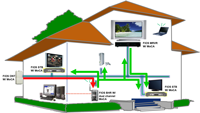NDS joins MoCA

NDS, a provider of content security and middleware technology for the pay-TV industry, has joined the Multimedia over Coax Alliance (MoCA) as an Associate member. NDS is the first conditional access (CA) vendor to join, according to MoCA, with the immediate motive being that NDS is already involved with international cable operator Liberty Global, whose Multimedia Home Gateway uses MoCA technology. But the move highlights MoCA’s growing momentum in some countries outside its U.S. heartland where it is already widely deployed, including some European countries with high cable penetration.
In the UK, where cable operator Virgin Media has approaching 30 percent of the pay-TV market, 56 percent of respondents to a survey conducted by MoCA in 2010 have two or more cable outlets in their homes, and 27 percent have three or more. In France, which is actually Europe’s IPTV stronghold, 55 percent of respondents had two or more coaxial outlets and 25 percent three or more. Poland was most ripe for MoCA, with 71 percent of respondents there having two or more coaxial outlets and 36 percent three or more. The Netherlands though, given that more than 90 percent of households there have cable TV, was a disappointment for MoCA. Only 45 percent of respondents have two or more coaxial outlets, and 15 percent three or more.
Overall, though results of this and other surveys have encouraged MoCA to step up its campaign in Europe and recruit operators and vendors there as members. The first European vendor to join was broadband cable and telecommunications equipment supplier Technetix, a broadband cable and telecommunications equipment supplier, which became an associate member in April 2010. There are also two major European set-top box vendors as associate members, UK based PACE and ADB of Switzerland.
Although service providers have been slower to sign up, MoCA expects European cable operators to start home trials before the end of 2011 and hopes this will demonstrate the performance and robustness of its latest MoCA 2.0 specification, which increases guaranteed throughput to 400Mb/s.
While there is no doubt that MoCA delivers the bit rate, latency and low error rate required to deliver multichannel services in the home, it remains to be seen whether operators will be prepared to make the significant investments needed to install the cable in homes that do not have it. Even where there are two or three coaxial outlets, it may still be necessary to extend the coverage. This is the opportunity for the main rival wired technology, the home plug A/V standard for power cables, which has the advantage of running over wires that are always there. The main challenge for power line lies in convincing operators that it really has banished fears over both reliability and performance through recent improvements in signal processing. Major chip set vendors such as Broadcom are agnostic over the home plug versus MoCA debate, and argue they can deliver robust solutions for both.
Meanwhile, the growing demand for access from wireless devices such as iPads will ensure that WiFi is part of the mix, at least for transmission of TV signals within rooms. Power or coaxial cables may then provide the backbone interconnecting two or more WiFi routers within the home.
Get the TV Tech Newsletter
The professional video industry's #1 source for news, trends and product and tech information. Sign up below.
